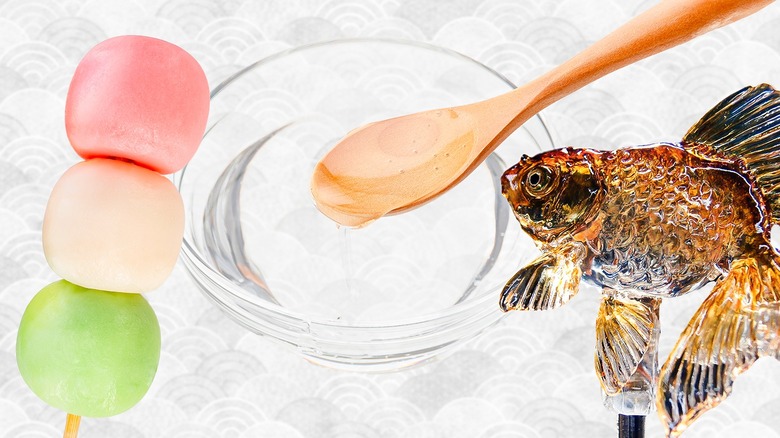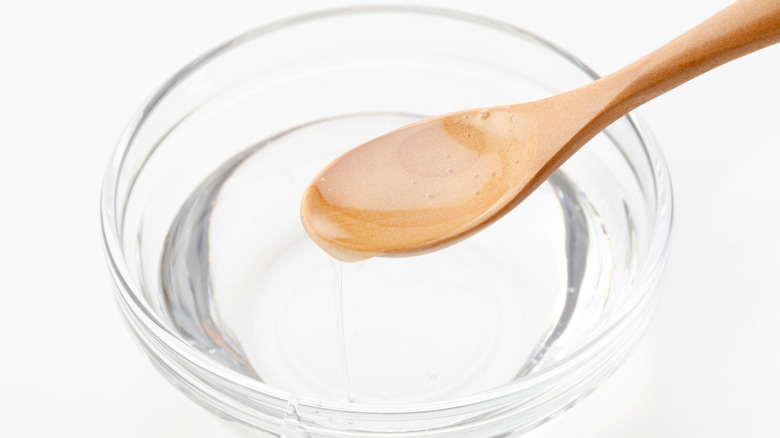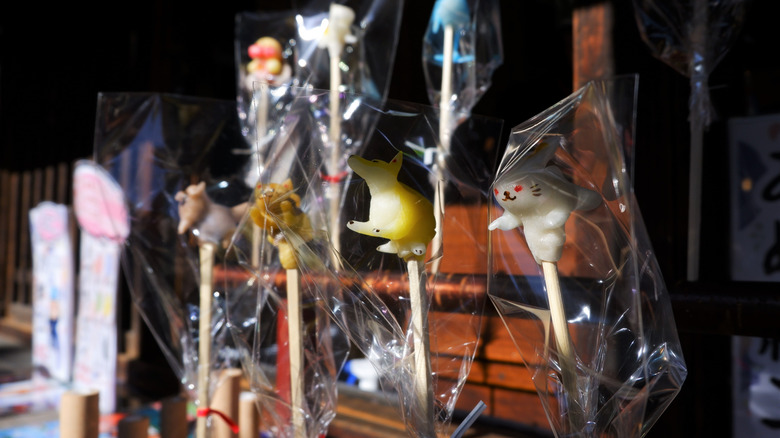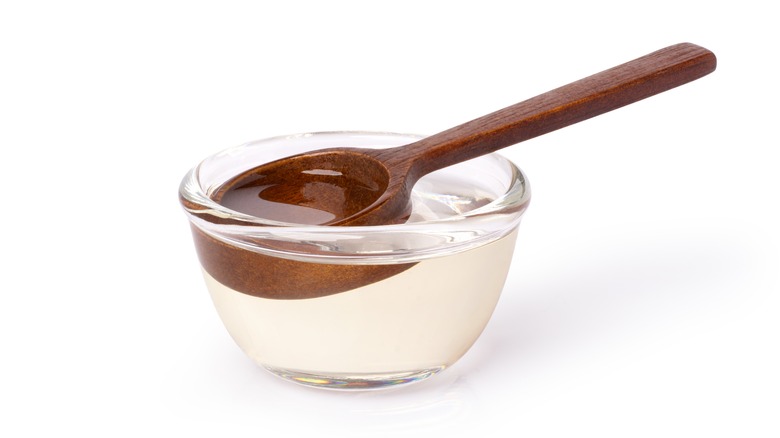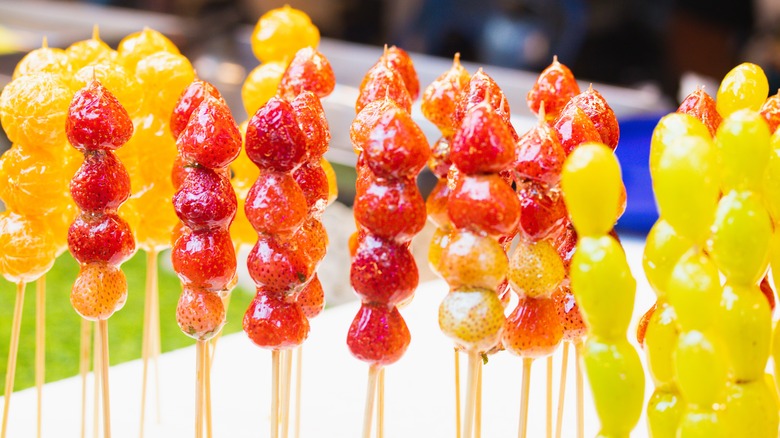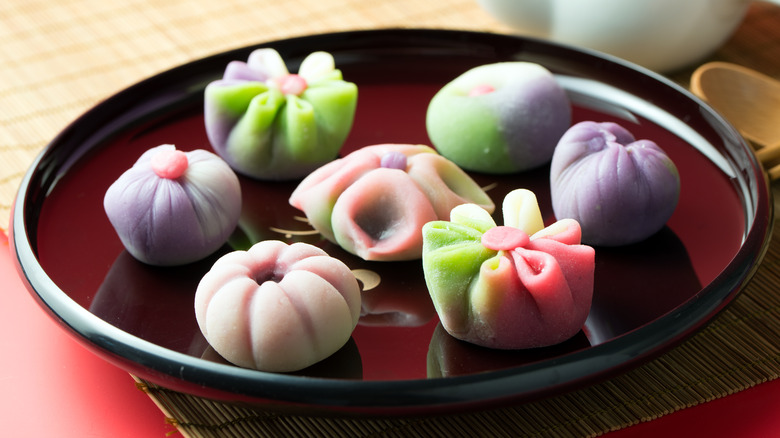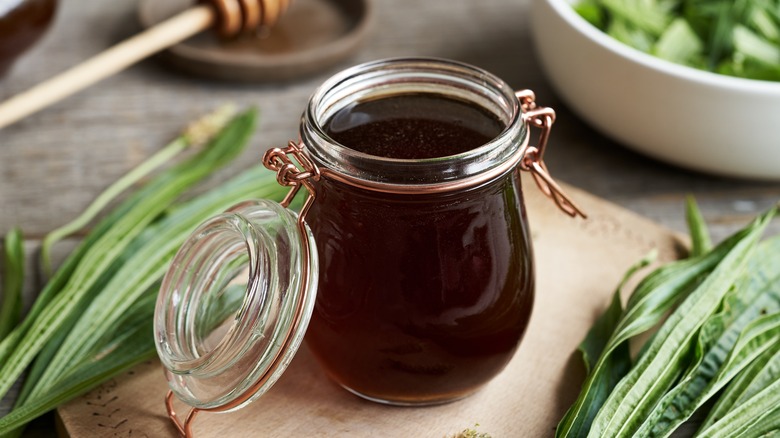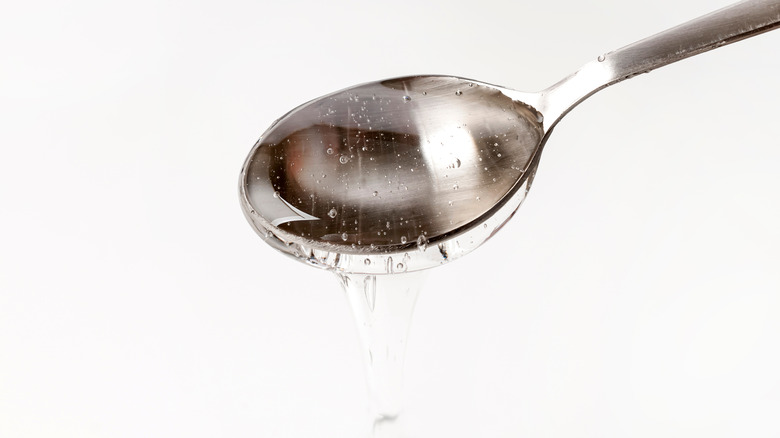What Is Mizuame Syrup And What Is It Used For?
Japan has so much to offer, especially in the culinary field. If you are planning a trip to Japan, you'll likely find sushi, soba noodles, and katsu, but if there's one thing you can't skip, it's Japanese candy. Before you go to Japan, there's an ingredient you should know: Mizuame. Mizuame (glutinous starch syrup) can be considered one of the first forms of candy in Japan. In one of the oldest stories of Japan, the first emperor, Emperor Jinmu, created candy to bring peace to the nation. Some of the earliest candies were made of rice-based sugary syrup, like mizuame.
You'll likely encounter mizuame without even realizing it, as it is a major ingredient in a variety of Japanese confections. Mizuame is incredibly delicious and can be eaten on its own, but it is also included in two of Japan's most famous delicacies, wagashi and amezaiku. If you go to Japan, make sure to keep an eye out for these treats because they take incredible craftsmanship and skill to make. Mizuame is a key ingredient in both dishes and once you try it, you'll be asking yourself where to find more.
What is mizuame syrup?
Mizuame, which translates to "water candy" is a popular Japanese sweetener that often comes in a syrup-like consistency. When split, mizu means water, and ame means candy. It is also called millet jelly and is commonly used in the Japanese art of amezaiku as well as in traditional wagashi, a type of confectionery. It has a viscous consistency and is as clear as water, with a strong sheen. Because of the sheen, it is used to give desserts a glossy appearance.
Mizuame is commonly sold in both syrup and taffy-like forms and can be consumed in ways similar to honey. Some people dip sticks into the mizuame, wrapping the syrup around the stick and eating it. It has uses in baking, such as when added to desserts like castella cake, a traditional Japanese treat sponge cake. In liquid form, mizuame can be added as a sweetener in coffee, tea, or even cocktails. However, its most common use is in candy. When heated, it can be molded and shaped, and once it loses heat, it hardens. Rather than being a regional specialty, mizuame is consumed throughout all of Japan, where it is especially popular as a street food during summer festivals.
History of mizuame
Mizuame, as a raw ingredient, has been made and consumed for centuries. It is thought to have originated in eighth-century Japan, during the Heian era, when its use in candy art (amezaiku) began. During the Heian period, it was common for people to make offerings at temples, and these mizuame candy sculptures were a popular option as a tribute. Mizuame really gained popularity during the Edo period, which was hundreds of years later, in the 17th century.
Candy became much more accessible to the general public during the Edo period as black sugar was introduced to the Japanese diet. People who opted to sell this candy for a living often took jobs as street-side vendors, sculpting mizuame into shapes. The act of candy sculpting became a performance in itself, and people would gather to watch the candy sellers craft animal and plant shapes out of the mizuame. In the Edo period, mizuame was wound on straws, which the artisans would blow through in a technique comparable to glass blowing. (The technique is no longer used because it doesn't meet food safety protocols.) These days, mizuame can be found at most grocery stores in Japan and is a common ingredient in a variety of Japanese desserts like dagashi, affordable and colorful snacks that are popular among children.
How is mizuame made?
Mizuame is a starchy sweetener typically made with rice. The traditional process starts with modifying the starches of glutinous rice into sugars. Glutinous rice, also known as sticky rice, contains a starch called amylopectin, which is responsible in part for the stickiness of the rice itself. When amylopectin is combined with malt, a type of maltose, or sugar, is produced through a natural enzymatic process in which the starch from the rice is broken down by amylase.
The remaining liquid is boiled down and eventually converted into syrup. The traditional method takes multiple days to make, as it needs time for the malting process to occur. It is possible to make mizuame at home in only 8 to 9 hours by using steamed glutinous rice and malt powder, a powder made from grain that has already been malted.
Mizuame is now made conventionally using another process, which is less traditional but also common and involves potato starch. Either potato or sweet potato starch is used in place of rice, while acids — sulfuric, hydrochloric, or nitric — replace the malt. The method also results in a sugary syrup. Mizuame is typically produced commercially using this method and is available for purchase year-round.
What does mizuame taste like?
Mizuame has a dominantly sweet flavor profile with very few other flavors that define it. Sugariness is the most dominant taste, but an undertone of malty starch can also be present, especially in hand-crafted versions made with the traditional process. These are sometimes known as "barley" mizuame. Most often, commercially made mizuame tastes similar to corn syrup in that they both have a pure saccharine characteristic without any other prevailing flavors coming through.
Although both are sugary substances, some believe that mizuame made with potato starch is less flavorful than that made with glutinous rice. Still, in its basic form, mizuame is a simple sweetener, which allows it to work well as an ingredient for other dishes or simply as the base of candy for other flavors to build on. The flavor of mizuame can be greatly affected by the ingredients that are added, such as fruit or flavored food dye.
How to eat mizuame
There are various ways to enjoy mizuame. Some opt to eat it like honey, dipping a stick into it and wrapping the sweetener into a taffy-like consistency that can be consumed on its own. Although it hardens on its own at room temperature, mizuame is soluble and thus can be mixed into hot or cold beverages for a touch of sweetness. After these, the next (and likely most common) variation of eating mizuame involves coating fruit in the substance to create a sweet, shiny exterior with a crisp, thin finish.
Mizuame can also be found in a range of Japanese pastries or wagashi, which are typically small sweets served with green tea. One common place where mizuame is used as an ingredient is in castella cake. This baked good is known for its springy texture and light, airy body. Mizuame may be used as a sweetener for the cake or used overtop to create a slick and brittle coating on the outside of castella.
In addition to wagashi, perhaps the most well-known way to eat mizuame is enjoying it as a candy sculpture, called amezaiku. Although amezaiku has extensive historical origins, it is an art form that is becoming more rare to see.
Mizuame is commonly used to make amezaiku
One of the most beautiful forms of edible art, amezaiku is a centuries-old Japanese tradition that entails sculpting hot mizuame syrup into shapes. The syrup is heated close to 200 degrees Fahrenheit, and artists mold the starchy syrup with their bare hands, moving quickly so they can shape the syrup before it sets. During this window, the mizuame syrup is pliable enough to pull and squeeze, and small scissors, tweezers, or needles are used to cut sharp edges. The hot syrup is molded on a stick, and the entire shaping process occurs quickly, taking about five minutes. Once shaped, the syrup is painted with food dye, creating a glass-like edible sculpture. The food dye is applied with tiny brushes, and the final products tend to depict a variety of animals.
This craft is not only beautiful, but it requires an incredible amount of training and skill, and only a handful of professionally trained artists still practice it today. An amezaiku artist is referred to as a takumi. There has been increased popularity for amezaiku in recent years, with wide respect remaining for the Japanese art form. Today, you can try amezaiku at specialty studios in cities like Tokyo or Kyoto, or if you're lucky, you can find a street-side artist making these beautiful mizuame sculptures during one of the many festivals in Japan.
Mizuame is a key ingredient in wagashi
Like amezaiku, wagashi are traditional Japanese confections that have been enjoyed for thousands of years, and which became popular and refined during the Edo period. Wagashi development during ancient times tracks with early variations of hanami dango and various types of mochi. However, whereas amezaiku is closer to a lollipop and refers to a very specific type of treat, there are many different types of wagashi. The diversity of wagashi ranges from those made with rice mochi to types made with bean paste; some are akin to pastry, and others take the form of candy. They are typically accompanied by green tea.
Many wagashi confections use mizuame, either as a sweetening agent or to create a glossy exterior on the desserts. A popular wagashi treat that uses mizuame is rakugan, which is a rice-based dessert that is put into beautifully molded shapes and dried. Mizuame adds sweetness and structure, but the dessert is known for it's dissolvable texture which has been compared the feeling of snow on your tongue.
Varieties of mizuame
Mizuame comes in several different forms. The more traditional variation uses glutinous rice and malt, while the popular commercial variation uses potato starch and acid. Both varieties serve the same purpose and have similar tastes, but if you're looking for a more natural process, be sure to check the label. In its basic form, syrup mizuame is sold either in jars or a plastic container.
Aside from the basic mizuame, various companies sell versions of mizuame that include additional flavorings or colors. For example, a company called Macrobiotic Asia sells a version of mizuame that includes kumquat, which is advertised as a natural medicine to ease sore throats. Additionally, some candy brands sell varieties of mizuame with added flavors or coloring. It should be noted that mizuame does not have any known nutritional benefits and that cooking with flavored or colored varieties of mizuame may greatly impact the final product, if you intend to use them for candy-making.
Mizuame substitutes
Mizuame can be difficult to find outside of Japan. Luckily, if you're intending to use it as a sweetener, there are a variety of options that can serve as good replacements.
One substitute for mizuame is other starch-based sweeteners like glucose syrup. Glucose syrup, which is typically made from corn or grain, is made from a similar process as mizuame and has the same neutral flavor. Because it hardens as well, it can serve the same purpose in candy making. It is affordable and often used in a variety of desserts, so it's easier to find in the U.S. With a similar viscosity and coloration to mizuame, glucose syrup can also replicate a glossy sheen. One thing to note is that this syrup is sweeter than mizuame, so when using it as a substitute, decrease the quantity.
Another substitute is mulyeot syrup, a Korean malt syrup product. Both mizuame and mulyeot are malt-based sweeteners with similar textures, coloration, and consistency. Mulyeot can be found at Asian specialty stores but isn't typically carried at big supermarkets in the U.S.
If all else fails, corn syrup and honey are still viable alternatives to mizuame that are easily accessible at big grocery chains. Non-flavored, clear corn syrup is ideal for candy making or glazing, but it is less viscous than mizuame, so certain recipes may need adapting. Honey is also a decent alternative, but it has a strong, distinct flavor that mizuame lacks and will not harden in the same way.
Where to buy mizuame
Mizuame can be found in grocery stores across all of Japan, but it can be difficult to find readily available elsewhere. It isn't guaranteed to be found in Asian supermarkets in the U.S., so ordering mizuame online is the best bet. Additionally, mizuame made in the traditional method with glutinous rice and malt may differ in cost from the mizuame made by acid hydrolysis.
There are also a variety of mizuame-based candies and herb-infused options that are popular. These are also hard to come across in Western supermarkets. If you aren't in Japan and are looking to try mizuame for yourself, online specialty stores are a great option. Packages or containers of mizuame range in quantity from 5-ounce sizes to 12 ounces, and the price can be anywhere from $4 to $9 for pure syrup, depending on if it has additional flavors or colorings or if it is made traditionally versus with acid hydrolysis. Similarly, mizuame candy is fairly cheap, ranging just under $2 depending on the maker or size.
Nutritional information for mizuame
Mizuame contains a large amount of carbohydrates and sugar and thus is high on the glycemic index scale. It is also high in calories and has little positive health effects. Different types of mizuame have different caloric content, but given that the syrup comes from malted rice or potatoes and is pure sugar, most types of mizuame will be similar in regards to having high sugar content.
Although mizuame on its own is unhealthy, it is a good substitute for table sugar, as it contains fewer calories on average than table sugar. It also has trace small quantities of iron, calcium, phosphorus, and potassium, but it should not be considered as a sufficient source for these elements. Some people use mizuame medicinally in a similar to honey in that it can ease sore throats. However, there is no research to prove that this is effective. Still, anecdotal evidence persists that when mixed with other ingredients like kumquat or herbs and melted into hot water, it can help to soothe throat pain.
How to store mizuame
Mizuame often comes in glass jars or plastic containers. The best way to store mizuame is to keep it in a dry, dark place. Mizuame would be safe if kept in a kitchen cupboard or pantry. As long as it isn't sitting in the sun, or in a room that isn't temperature-stabilized, it should be fine. Try to avoid keeping mizuame in the refrigerator.
One of the best qualities of mizuame is its ability to change consistency in different temperatures. In this case, although mizuame won't go bad if kept in the refrigerator, it will likely stiffen up, making it difficult to consume. Mizuame is shelf stable and can be stored at room temperature for around 6-12 months on average. Certain pre-packaged Japanese dagashi treats with mizuame have a shorter shelf life than mizuame itself, so it is recommended to read the labels of any mizuame product you come across.
